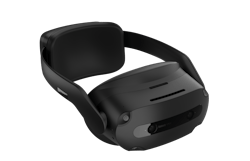Check out Electronic Design's coverage of CES 2024.
What you’ll learn:
- How AR/VR/MR is used in industrial applications.
- Why Lenovo’s total solution makes a difference.
- What are the characteristics of the ThinkReality VRX headset?
The ThinkReality VRX headset developed by Lenovo supports mixed-reality (MR), augmented-reality (AR) and virtual-reality (VR) applications. It’s intended primarily for industrial and commercial applications, though, where hardware and software support is critical after purchase of the headset.
MR/AR/VR is often shortened to XR to cover all the bases. I talked with Vishal Shah, Lenovo’s General Manager for XR and Metaverse, about the hardware and software platform (see the video above).
The ThinkReality VRX has a resolution of 2280 × 2280 pixels per eye with a 95-degree field of view, which is similar to Meta’s Quest 3 (see figure). The big difference is the two high-resolution HD color cameras that provide pass-through images for MR and AR support with a latency of less than 10 ms. It employs four other cameras to track six degrees of freedom (6DoF) head movement. The wireless hand controllers also have 6DoF.
The pancake lens, incorporated in most new XR headsets, reduces the thickness of the front part of the headset. A large 6900-mAh battery in the rear balances it out, making the headset more comfortable when used for long periods of time.
The system. built around Qualcomm’s Snapdragon XR2+, is designed to support up to seven cameras and runs Android 12. It has 12 GB of RAM and 128 GB of flash storage.
The key to Lenovo’s offering is the ThinkReality software framework and its third-party support. The ThinkReality Cloud Portal enables companies to manage devices and applications. The ThinkReality Developer Platform builds on Qualcomm’s Snapdragon Spaces SDK software.

